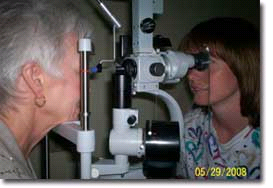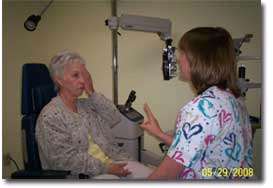When you come into our office, our front desk staff will greet you with a smile. To save time at the beginning of your visit, please download or complete your registration paperwork here.
Upon registration, one of our friendly technicians will call you back to begin your visit. Our technicians want to get to know more about you and anything troubling your eyes. After learning more about your history, the technician will begin the eye exam.


The technicians will first check your vision to learn how well you are seeing. Next, they will shine a light in your eyes to see how your pupils react. Abnormalities of the pupil sometimes indicate a disease process involving your optic nerve. They will then check your ocular alignment and movement, looking for any problems with the nerves and muscles that move your eyes.


Next, they will check your peripheral vision. Abnormalities of your peripheral vision can suggest optic nerve, retinal, or other diseases. Upon completion of these preliminary tests, the technician will begin to look at your eyes and make note of any abnormal or significant conditions, followed by placement of a local anesthetic drop in your eyes in order to check your intraocular eye pressure, an important screening test for glaucoma.
Once the technician has measured your eye pressure, they will place a few more drops in your eyes to dilate your pupils. These drops will open the pupils of your eyes and allow your ophthalmologist to perform a detailed exam. It will usually take 15-30 minutes for your eyes to dilate. While you wait, please feel free to browse in our optical shop, or watch TV in our dilation waiting room.
After your pupils are fully dilated, you will return to an examination room, where your ophthalmologist will perform a detailed eye exam, including a detailed examination of your retina. The lights used during this portion of the exam will seem very bright to you, but they will not hurt or damage your eyes. Your vision, especially your near vision, will be blurry once your eyes have been dilated and examined. You may wish to have a driver accompany you if you have never had an eye exam or if you experienced difficulty driving after a previous eye exam.
Once your ophthalmologist has reviewed your history and performed a comprehensive eye exam, they will take the time to discuss your particular situation with you and, if necessary, develop a treatment plan tailored to your needs and preferences. Our goal is to provide a comfortable experience for you during your visit, so if there is anything that we can do to improve your visit, please let your doctor or technician know.